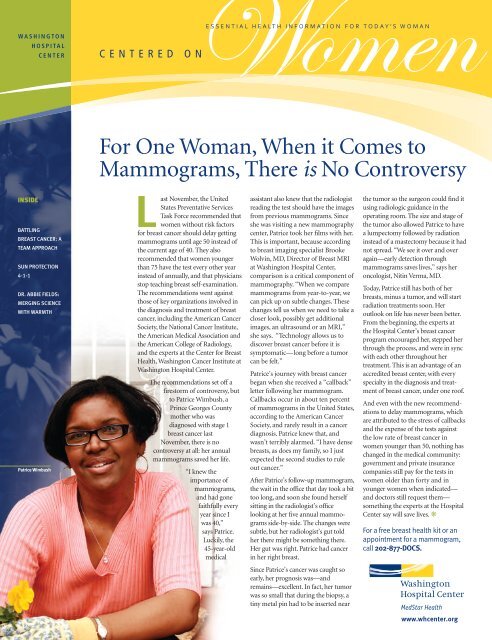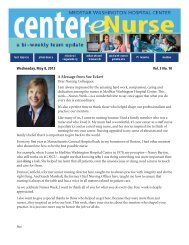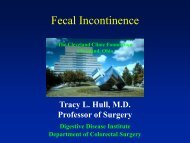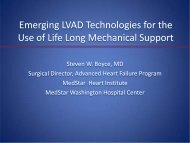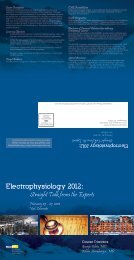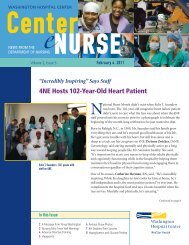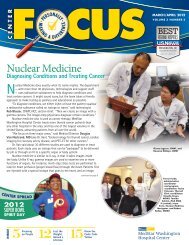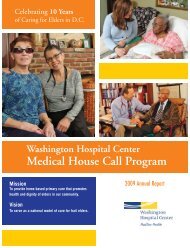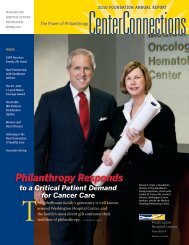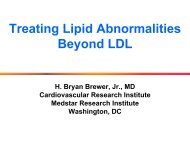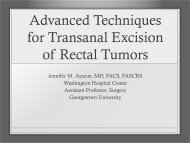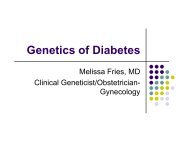For One Woman, When it Comes to Mammograms, There is No ...
For One Woman, When it Comes to Mammograms, There is No ...
For One Woman, When it Comes to Mammograms, There is No ...
Create successful ePaper yourself
Turn your PDF publications into a flip-book with our unique Google optimized e-Paper software.
NWomen<br />
E s s E n t i a l H E a l t H i n f o r m a t i o n f o r t o d a y ’ s W o m a n<br />
W A S H I N G T O N<br />
H O S P I TA L<br />
C E N T E R C E N T E R E D O<br />
INSIDE<br />
BATTLING<br />
BREAST CANCER: A<br />
TEAM APPROACH<br />
SUN PROTECTION<br />
4-1-1<br />
DR. ABBIE FIELDS:<br />
MERGING SCIENCE<br />
WITH WARMTH<br />
Patrice Wimbush<br />
<strong>For</strong> <strong>One</strong> <strong>Woman</strong>, <strong>When</strong> <strong>it</strong> <strong>Comes</strong> <strong>to</strong><br />
<strong>Mammograms</strong>, <strong>There</strong> <strong>is</strong> <strong>No</strong> Controversy<br />
Last <strong>No</strong>vember, the Un<strong>it</strong>ed<br />
States Preventative Services<br />
Task <strong>For</strong>ce recommended that<br />
women w<strong>it</strong>hout r<strong>is</strong>k fac<strong>to</strong>rs<br />
for breast cancer should delay getting<br />
mammograms until age 50 instead of<br />
the current age of 40. They also<br />
recommended that women younger<br />
than 75 have the test every other year<br />
instead of annually, and that physicians<br />
s<strong>to</strong>p teaching breast self-examination.<br />
The recommendations went against<br />
those of key organizations involved in<br />
the diagnos<strong>is</strong> and treatment of breast<br />
cancer, including the American Cancer<br />
Society, the National Cancer Inst<strong>it</strong>ute,<br />
the American Medical Association and<br />
the American College of Radiology,<br />
and the experts at the Center for Breast<br />
Health, Washing<strong>to</strong>n Cancer Inst<strong>it</strong>ute at<br />
Washing<strong>to</strong>n Hosp<strong>it</strong>al Center.<br />
The recommendations set off a<br />
fires<strong>to</strong>rm of controversy, but<br />
<strong>to</strong> Patrice Wimbush, a<br />
Prince Georges County<br />
mother who was<br />
diagnosed w<strong>it</strong>h stage 1<br />
breast cancer last<br />
<strong>No</strong>vember, there <strong>is</strong> no<br />
controversy at all: her annual<br />
mammograms saved her life.<br />
“I knew the<br />
importance of<br />
mammograms,<br />
and had gone<br />
fa<strong>it</strong>hfully every<br />
year since I<br />
was 40,”<br />
says Patrice.<br />
Luckily, the<br />
45-year-old<br />
medical<br />
ass<strong>is</strong>tant also knew that the radiolog<strong>is</strong>t<br />
reading the test should have the images<br />
from previous mammograms. Since<br />
she was v<strong>is</strong><strong>it</strong>ing a new mammography<br />
center, Patrice <strong>to</strong>ok her films w<strong>it</strong>h her.<br />
Th<strong>is</strong> <strong>is</strong> important, because according<br />
<strong>to</strong> breast imaging special<strong>is</strong>t Brooke<br />
Wolvin, MD, Direc<strong>to</strong>r of Breast MRI<br />
at Washing<strong>to</strong>n Hosp<strong>it</strong>al Center,<br />
compar<strong>is</strong>on <strong>is</strong> a cr<strong>it</strong>ical component of<br />
mammography. “<strong>When</strong> we compare<br />
mammograms from year-<strong>to</strong>-year, we<br />
can pick up on subtle changes. These<br />
changes tell us when we need <strong>to</strong> take a<br />
closer look, possibly get add<strong>it</strong>ional<br />
images, an ultrasound or an MRI,”<br />
she says. “Technology allows us <strong>to</strong><br />
d<strong>is</strong>cover breast cancer before <strong>it</strong> <strong>is</strong><br />
symp<strong>to</strong>matic—long before a tumor<br />
can be felt.”<br />
Patrice’s journey w<strong>it</strong>h breast cancer<br />
began when she received a “callback”<br />
letter following her mammogram.<br />
Callbacks occur in about ten percent<br />
of mammograms in the Un<strong>it</strong>ed States,<br />
according <strong>to</strong> the American Cancer<br />
Society, and rarely result in a cancer<br />
diagnos<strong>is</strong>. Patrice knew that, and<br />
wasn’t terribly alarmed. “I have dense<br />
breasts, as does my family, so I just<br />
expected the second studies <strong>to</strong> rule<br />
out cancer.”<br />
After Patrice’s follow-up mammogram,<br />
the wa<strong>it</strong> in the office that day <strong>to</strong>ok a b<strong>it</strong><br />
<strong>to</strong>o long, and soon she found herself<br />
s<strong>it</strong>ting in the radiolog<strong>is</strong>t’s office<br />
looking at her five annual mammograms<br />
side-by-side. The changes were<br />
subtle, but her radiolog<strong>is</strong>t’s gut <strong>to</strong>ld<br />
her there might be something there.<br />
Her gut was right. Patrice had cancer<br />
in her right breast.<br />
Since Patrice’s cancer was caught so<br />
early, her prognos<strong>is</strong> was—and<br />
remains—excellent. In fact, her tumor<br />
was so small that during the biopsy, a<br />
tiny metal pin had <strong>to</strong> be inserted near<br />
the tumor so the surgeon could find <strong>it</strong><br />
using radiologic guidance in the<br />
operating room. The size and stage of<br />
the tumor also allowed Patrice <strong>to</strong> have<br />
a lumpec<strong>to</strong>my followed by radiation<br />
instead of a mastec<strong>to</strong>my because <strong>it</strong> had<br />
not spread. “We see <strong>it</strong> over and over<br />
again—early detection through<br />
mammograms saves lives,” says her<br />
oncolog<strong>is</strong>t, N<strong>it</strong>in Verma, MD.<br />
Today, Patrice still has both of her<br />
breasts, minus a tumor, and will start<br />
radiation treatments soon. Her<br />
outlook on life has never been better.<br />
From the beginning, the experts at<br />
the Hosp<strong>it</strong>al Center’s breast cancer<br />
program encouraged her, stepped her<br />
through the process, and were in sync<br />
w<strong>it</strong>h each other throughout her<br />
treatment. Th<strong>is</strong> <strong>is</strong> an advantage of an<br />
accred<strong>it</strong>ed breast center, w<strong>it</strong>h every<br />
specialty in the diagnos<strong>is</strong> and treatment<br />
of breast cancer, under one roof.<br />
And even w<strong>it</strong>h the new recommendations<br />
<strong>to</strong> delay mammograms, which<br />
are attributed <strong>to</strong> the stress of callbacks<br />
and the expense of the tests against<br />
the low rate of breast cancer in<br />
women younger than 50, nothing has<br />
changed in the medical commun<strong>it</strong>y:<br />
government and private insurance<br />
companies still pay for the tests in<br />
women older than forty and in<br />
younger women when indicated—<br />
and doc<strong>to</strong>rs still request them—<br />
something the experts at the Hosp<strong>it</strong>al<br />
Center say will save lives. ❋<br />
<strong>For</strong> a free breast health k<strong>it</strong> or an<br />
appointment for a mammogram,<br />
call 202-877-DOCS.<br />
www.whcenter.org
A N E W V I E W O N<br />
Breast Cancer<br />
Recent progress in the treatment of<br />
breast cancer offers new hope <strong>to</strong> the<br />
nearly 200 thousand women<br />
diagnosed each year. Scient<strong>is</strong>ts know<br />
more about the makeup of tumors<br />
than ever before, allowing them <strong>to</strong><br />
develop medicines that target specific<br />
types of tumors. Perhaps the most<br />
significant advance was the advent of<br />
such a treatment—Herceptin. ®<br />
According <strong>to</strong> Sandra Swain, MD,<br />
medical direc<strong>to</strong>r of Washing<strong>to</strong>n Cancer<br />
Inst<strong>it</strong>ute, Washing<strong>to</strong>n Hosp<strong>it</strong>al Center,<br />
“Herceptin <strong>is</strong> the biggest advance in<br />
the systemic treatment of HER2<br />
pos<strong>it</strong>ive breast cancer we have had.”<br />
Since the Food and Drug Admin<strong>is</strong>tration<br />
approved Herceptin in 1998, the<br />
drug has markedly impacted the<br />
survival and recurrence rates associated<br />
w<strong>it</strong>h HER2 pos<strong>it</strong>ive breast cancer.<br />
HER2 pos<strong>it</strong>ive breast tumors have<br />
<strong>to</strong>o much of a protein found in the<br />
body that causes cells <strong>to</strong> grow and<br />
divide. HER2 pos<strong>it</strong>ive breast cancer <strong>is</strong><br />
known <strong>to</strong> spread rapidly and come<br />
back more frequently than <strong>it</strong>s HER2<br />
negative form. About twenty percent<br />
of breast tumors are HER2 pos<strong>it</strong>ive.<br />
Herceptin <strong>is</strong> not chemotherapy;<br />
rather, <strong>it</strong> <strong>is</strong> an antibody that attacks<br />
the HER2 protein. <strong>When</strong> given in<br />
combination w<strong>it</strong>h chemotherapy, <strong>it</strong><br />
reduces the recurrence of these<br />
tumors by 50 percent.<br />
“Before, patients w<strong>it</strong>h HER2 pos<strong>it</strong>ive<br />
breast cancer did very poorly,” adds<br />
Dr. Swain. “Herceptin has saved a lot<br />
of lives, and has essentially changed<br />
the way medical professionals view<br />
HER2 pos<strong>it</strong>ive breast cancer.”<br />
“Herceptin has saved<br />
a lot of lives…”<br />
— S A N D R A S WA I N , M D<br />
Battling Breast Cancer<br />
Takes a Team of Warriors<br />
Hosp<strong>it</strong>al Center Offers the Full Range of Services Under <strong>One</strong> Roof<br />
a<br />
ccording <strong>to</strong> the National<br />
Cancer Inst<strong>it</strong>ute, one in<br />
nine women under the age<br />
of 85 will develop breast cancer<br />
during her lifetime.<br />
But there <strong>is</strong> good news, according <strong>to</strong><br />
Sandra Swain, MD, medical direc<strong>to</strong>r<br />
of Washing<strong>to</strong>n Cancer Inst<strong>it</strong>ute at<br />
Washing<strong>to</strong>n Hosp<strong>it</strong>al Center.<br />
“Advances in treatment have<br />
improved survival of all types of<br />
breast cancer during the last several<br />
years. And, many of these therapies<br />
allow women <strong>to</strong> maintain a better<br />
qual<strong>it</strong>y of life during their treatment.<br />
That can include continuing <strong>to</strong> work<br />
and care for their families,” she says.<br />
“Chemotherapy treatments are much<br />
better <strong>to</strong>lerated than in the past. I have<br />
patients receiving chemotherapy,<br />
and you wouldn’t know.”<br />
She adds that “w<strong>it</strong>h the advent of the<br />
Oncotype DX® test, we can determine<br />
the genetic makeup of a tumor,<br />
whether <strong>it</strong> will respond <strong>to</strong> chemotherapy,<br />
and how likely the cancer <strong>is</strong><br />
<strong>to</strong> come back. Th<strong>is</strong> allows many<br />
women <strong>to</strong> avoid<br />
the rigors of<br />
chemotherapy<br />
al<strong>to</strong>gether w<strong>it</strong>hout<br />
r<strong>is</strong>king longterm<br />
survival.”<br />
And, the Hosp<strong>it</strong>al<br />
Center offers<br />
access <strong>to</strong> a wide array of proven<br />
clinical trials, including one that can<br />
shorten a woman’s course of radiation<br />
therapy from six weeks <strong>to</strong> five<br />
days. So where should a woman w<strong>it</strong>h<br />
breast cancer turn? Most are referred<br />
<strong>to</strong> a breast surgeon, who removes<br />
the tumor and connects her <strong>to</strong> other<br />
professionals for adjuvant—or<br />
follow-up—treatment, such as<br />
radiation, chemotherapy, hormone<br />
or biologic therapies. However, while<br />
the surgeon <strong>is</strong> the first provider in<br />
the continuum of breast cancer care,<br />
breast surgeon Marc Bo<strong>is</strong>vert, MD,<br />
medical direc<strong>to</strong>r of the hosp<strong>it</strong>al’s<br />
Center for Breast Health, recommends<br />
seeking out an accred<strong>it</strong>ed<br />
breast center as a first step.<br />
“The treatment of breast cancer <strong>is</strong><br />
interd<strong>is</strong>ciplinary, and should be that<br />
way from the start,” he says. The<br />
Hosp<strong>it</strong>al Center’s breast cancer<br />
program <strong>is</strong> accred<strong>it</strong>ed by the<br />
National Accred<strong>it</strong>ation Program for<br />
Breast Centers (NAPBC), which<br />
requires programs <strong>to</strong> demonstrate<br />
outstanding qual<strong>it</strong>y and encompass<br />
the full range of diagnostic and<br />
treatment options. Accred<strong>it</strong>ed<br />
programs also participate in clinical<br />
trials and offer extensive psycho-<br />
The abil<strong>it</strong>y <strong>to</strong> understand the whole picture <strong>is</strong> a<br />
big advantage of seeking care from a comprehensive<br />
breast cancer program.<br />
social, spir<strong>it</strong>ual, family and qual<strong>it</strong>yof-life<br />
services, as well as cancer<br />
genetics services. And at the Hosp<strong>it</strong>al<br />
Center, all of th<strong>is</strong> <strong>is</strong> available on the<br />
Cancer Inst<strong>it</strong>ute’s campus.<br />
At the Hosp<strong>it</strong>al Center, new breast<br />
cancer patients are connected <strong>to</strong> the<br />
multid<strong>is</strong>ciplinary team from the<br />
start, where they meet individually<br />
w<strong>it</strong>h each d<strong>is</strong>cipline <strong>to</strong> learn about<br />
the process and d<strong>is</strong>cuss treatment<br />
options. Then, the team gathers <strong>to</strong><br />
d<strong>is</strong>cuss the case, recommending<br />
an individualized treatment plan.<br />
Th<strong>is</strong> <strong>is</strong> called an interd<strong>is</strong>ciplinary<br />
approach, and ensures that every<br />
dec<strong>is</strong>ion made incorporates the<br />
full range of services of the cancer<br />
program, all revolving around the<br />
patient’s needs.<br />
Marc Bo<strong>is</strong>vert, MD and a breast<br />
cancer patient<br />
Generally, the first prior<strong>it</strong>y in breast<br />
cancer care <strong>is</strong> the removal of the<br />
tumor. <strong>For</strong> early stage tumors, the<br />
Center for Breast Health suggests<br />
lumpec<strong>to</strong>my w<strong>it</strong>h radiation <strong>to</strong> most<br />
patients. According <strong>to</strong> plastic surgeon<br />
Rafael Conv<strong>it</strong>, MD, “for early stage<br />
tumors, there <strong>is</strong> no difference in 15<br />
year survival w<strong>it</strong>h th<strong>is</strong> approach.”<br />
He works w<strong>it</strong>h the breast surgeon<br />
from the beginning, planning the<br />
inc<strong>is</strong>ion <strong>to</strong> allow for the best cosmetic<br />
result. Once the tumor and surrounding<br />
t<strong>is</strong>sue<br />
are removed,<br />
Dr. Conv<strong>it</strong><br />
follows, using<br />
the remaining<br />
t<strong>is</strong>sue <strong>to</strong> reshape<br />
the breast.<br />
Following<br />
radiation, which can create slight<br />
deform<strong>it</strong>ies in the t<strong>is</strong>sue, fat from<br />
other areas of the body can be<br />
injected <strong>to</strong> make final adjustments.<br />
“W<strong>it</strong>h lumpec<strong>to</strong>my, a woman can<br />
keep her own breast, w<strong>it</strong>h <strong>it</strong>s natural<br />
feel and sensation—<strong>it</strong>’s better that<br />
way,” he says. Mastec<strong>to</strong>my may be<br />
necessary in certain cases. If so, stateof-the-art<br />
reconstruction services<br />
are available.<br />
The abil<strong>it</strong>y <strong>to</strong> understand the whole<br />
picture <strong>is</strong> a big advantage of seeking<br />
care from a comprehensive breast<br />
cancer program. “<strong>When</strong> patients<br />
come in w<strong>it</strong>h a new diagnos<strong>is</strong>, they<br />
are caught up in the moment of<br />
‘I’m dying of breast cancer,’ and<br />
immediately want their breasts<br />
removed. Once they meet w<strong>it</strong>h the<br />
C O N T I N U E D O N PA G E 4
Sun Protection 4-1-1<br />
Controlling Sun Exposure Cr<strong>it</strong>ical, Regardless of Skin Color<br />
a<br />
h, spring has sprung! And<br />
w<strong>it</strong>h warm weather upon<br />
us, now <strong>is</strong> a good time <strong>to</strong><br />
remember that sun protection <strong>is</strong><br />
essential, regardless of skin color or<br />
type. The incidence of melanoma—<br />
the most serious form of skin<br />
cancer—has increased markedly<br />
across the population over the last<br />
two decades, and experts attribute<br />
the increase <strong>to</strong> damage from ultraviolet<br />
(UV) rays. Whether people<br />
are intentionally seeking a tan or<br />
they are merely getting incidental<br />
UV exposure from outdoor jobs or<br />
activ<strong>it</strong>ies, sun protection <strong>is</strong> essential.<br />
According <strong>to</strong> skin cancer expert<br />
Suraj Venna, MD, “there <strong>is</strong> no such<br />
thing as a safe tan, as any amount of<br />
ultraviolet <strong>is</strong> damaging. And,<br />
although the r<strong>is</strong>k of melanoma <strong>is</strong><br />
lower for people of color, they still<br />
need <strong>to</strong> avoid sun damage.”<br />
Given the abundance of sun-care<br />
products on the market <strong>to</strong>day, <strong>it</strong><br />
should be fairly easy for someone <strong>to</strong><br />
find a product that gives them<br />
adequate sun protection and f<strong>it</strong>s<br />
their lifestyle. But sometimes, having<br />
<strong>to</strong>o many choices can be mindboggling.<br />
Dr. Venna, direc<strong>to</strong>r of<br />
the Melanoma Center, Washing<strong>to</strong>n<br />
Cancer Inst<strong>it</strong>ute at Washing<strong>to</strong>n<br />
Hosp<strong>it</strong>al Center, helps unravel the<br />
mysteries of sun protection w<strong>it</strong>h<br />
useful information and a few tips:<br />
<strong>There</strong> are two types of sunscreen:<br />
physical and chemical.<br />
Physical sunscreens contain<br />
e<strong>it</strong>her the ingredients zinc or<br />
t<strong>it</strong>anium. They essentially<br />
provide an “opaque<br />
umbrella” over the DNA<br />
of the skin’s cells, which,<br />
when damaged, <strong>is</strong> where<br />
skin cancer begins. Physical<br />
sunscreens reflect and<br />
scatter harmful ultraviolet<br />
(UV) rays away from the<br />
skin, effectively blocking<br />
the sun. Physical sunscreens<br />
have several benef<strong>it</strong>s: they<br />
are less likely <strong>to</strong> irr<strong>it</strong>ate the skin,<br />
tend <strong>to</strong> be more waterproof,<br />
are effective immediately upon<br />
application and are easier <strong>to</strong><br />
ensure complete coverage when<br />
applied because they are ne<strong>it</strong>her<br />
clear nor absorbed. UV rated<br />
protective clothing also provides<br />
an effective physical barrier<br />
from the sun.<br />
Chemical sunscreens create a<br />
chemical reaction that allows<br />
the skin <strong>to</strong> absorb UV rays,<br />
preventing them from entering<br />
the cell’s DNA. Although<br />
many people prefer chemical<br />
sunscreens because they are not<br />
v<strong>is</strong>ible on the skin, they must be<br />
applied about a half-hour before<br />
the skin can be exposed <strong>to</strong> the<br />
sun, so th<strong>is</strong> protective chemical<br />
reaction can take place.<br />
Spray-on sunscreens, wildly<br />
popular, convenient and easier <strong>to</strong><br />
apply, can be more difficult <strong>to</strong><br />
ensure adequate coverage, and tend<br />
<strong>to</strong> have a higher concentration of<br />
water, causing them <strong>to</strong> lose their<br />
effectiveness more quickly.<br />
Sunscreens can be labeled as<br />
water-res<strong>is</strong>tant or waterproof. Go<br />
for waterproof, especially if you<br />
plan on sweating or swimming.<br />
And be sure <strong>to</strong> use a “broadspectrum”<br />
sunscreen.<br />
ONWomen CENTERED |<br />
Although there are sunscreens<br />
w<strong>it</strong>h SPF as high as 100, SPF 50 <strong>is</strong><br />
adequate, as <strong>it</strong> blocks more than<br />
98 percent of the sun’s harmful<br />
rays. “We believe that higher SPF<br />
sunscreens create a false sense of<br />
secur<strong>it</strong>y, and people don’t reapply<br />
often enough,” says Dr. Venna.<br />
The key <strong>to</strong> the effective use of sunscreen<br />
<strong>is</strong> <strong>to</strong> apply <strong>it</strong> abundantly<br />
and frequently. “Sunscreen,<br />
regardless of the SPF value, must<br />
be reapplied every two <strong>to</strong> three<br />
hours—more frequently when<br />
swimming. And use a lot,” says<br />
Dr. Venna. Ample, complete<br />
coverage <strong>is</strong> the best way <strong>to</strong> ensure<br />
adequate protection.<br />
Don’t forget your eyes. “In the<br />
back of the eye, the retina has<br />
pigment producing cells that<br />
can develop moles and ocular<br />
melanoma. Think of your eyes in<br />
the same way as your skin, and use<br />
sunglasses that block all UV rays.”<br />
<strong>For</strong> children, Dr. Venna recommends<br />
physical sunscreens,<br />
WASHINGTON HOSPITAL CENTER | WWW.WHCENTER.ORG<br />
and favors a combination<br />
of rated Ultraviolet Protection<br />
Fac<strong>to</strong>r (UPF) clothing, hats,<br />
sunscreen and sunglasses. “A<br />
child should never get sunburn,”<br />
he emphasizes.❋<br />
<strong>For</strong> more information or an<br />
appointment w<strong>it</strong>h our experts,<br />
call 202-877-DOCS, or v<strong>is</strong><strong>it</strong> our<br />
webs<strong>it</strong>e at WHCenter.org.<br />
Hosp<strong>it</strong>al Center First in<br />
the Area <strong>to</strong> Acquire Large MRI<br />
Women who need breast magnetic resonance imaging (MRI) can count on a more comfortable,<br />
less stressful experience at Washing<strong>to</strong>n Hosp<strong>it</strong>al Center, thanks <strong>to</strong> <strong>it</strong>s new Toshiba T<strong>it</strong>an MRI<br />
and <strong>it</strong>s accompanying Sentinelle breast coil. The machine offers extraordinary image qual<strong>it</strong>y,<br />
and the widest and shortest opening available, making <strong>it</strong> more spacious than any other un<strong>it</strong> in<br />
the area. The large size of the opening, combined w<strong>it</strong>h the un<strong>it</strong>’s weight capac<strong>it</strong>y of 550 pounds,<br />
make <strong>it</strong> much easier for overweight or claustrophobic patients <strong>to</strong> have the test instead of having<br />
<strong>to</strong> use an open MRI, which doesn’t provide the same image qual<strong>it</strong>y.<br />
A coil <strong>is</strong> a component of the imaging process specific <strong>to</strong> the area of the body being studied.<br />
<strong>For</strong> breast MRI, the T<strong>it</strong>an’s Sentinelle coil has 12 Tempur-Pedic® pads that can be adjusted<br />
for the optimal comfort of every patient, and holds more breast t<strong>is</strong>sue than any other on the<br />
market. Since women are laying face-down during a breast MRI, comfort <strong>is</strong> very important.<br />
“Breast MRI <strong>is</strong> a terrific use of technology, but <strong>it</strong> never replaces trad<strong>it</strong>ional mammography,”<br />
says Brooke Wolvin, MD, Direc<strong>to</strong>r of Breast MRI at Washing<strong>to</strong>n Hosp<strong>it</strong>al Center.<br />
“Complementary <strong>to</strong> mammography, <strong>it</strong> <strong>is</strong> most often used for the screening of<br />
women at high r<strong>is</strong>k for breast cancer, for some women who have been<br />
diagnosed w<strong>it</strong>h breast cancer prior <strong>to</strong> surgery, or <strong>to</strong> determine whether a<br />
tumor <strong>is</strong> responding <strong>to</strong> treatment. Breast MRI can also be used <strong>to</strong> check<br />
certain types of breast implants for leakage.”<br />
Washing<strong>to</strong>n Hosp<strong>it</strong>al Center <strong>is</strong> the only facil<strong>it</strong>y in the area w<strong>it</strong>h th<strong>is</strong> type of<br />
equipment. <strong>For</strong> more information call 202-877-6133.
110 Irving Street, NW<br />
Washing<strong>to</strong>n, DC 20010<br />
nformation And Advice <strong>For</strong> The Maturing <strong>Woman</strong><br />
Women CENTERED ON<br />
Centered on Women <strong>is</strong> produced by the<br />
Public Affairs Department of Washing<strong>to</strong>n<br />
Hosp<strong>it</strong>al Center, 110 Irving Street, NW,<br />
Washing<strong>to</strong>n, DC 20010-2975.<br />
www.WHCenter.org<br />
Officers<br />
Harr<strong>is</strong>on J. Rider III, President,<br />
Washing<strong>to</strong>n Hosp<strong>it</strong>al Center<br />
Marc N. Duber, Chairman of the Board,<br />
Washing<strong>to</strong>n Hosp<strong>it</strong>al Center<br />
Kenneth A. Samet, President and CEO,<br />
MedStar Health<br />
Jan<strong>is</strong> M. Orlowski, MD, MACP, Senior<br />
Vice President and Chief Medical Officer,<br />
Washing<strong>to</strong>n Hosp<strong>it</strong>al Center<br />
Carolyn Hammond, Interim Vice President,<br />
Public Affairs and Marketing,<br />
Washing<strong>to</strong>n Hosp<strong>it</strong>al Center<br />
Julie Stan<strong>is</strong>h, Direc<strong>to</strong>r,<br />
Marketing Communications,<br />
Washing<strong>to</strong>n Hosp<strong>it</strong>al Center<br />
Washing<strong>to</strong>n Hosp<strong>it</strong>al Center <strong>is</strong> a not-forprof<strong>it</strong>,<br />
926-bed acute care teaching and<br />
research hosp<strong>it</strong>al based in <strong>No</strong>rthwest<br />
Washing<strong>to</strong>n, D.C. It <strong>is</strong> the largest private<br />
medical center in the nation’s cap<strong>it</strong>al,<br />
among the 25 largest hosp<strong>it</strong>als in the mid-<br />
Atlantic and the referral center for the<br />
region’s most complex medical cases. The<br />
Hosp<strong>it</strong>al Center cons<strong>is</strong>tently ranks among<br />
the nation’s <strong>to</strong>p hosp<strong>it</strong>als in the research<br />
and treatment of cardiovascular and kidney<br />
d<strong>is</strong>ease, cancer, stroke, endocrine<br />
d<strong>is</strong>orders, neurological injury and illness,<br />
as well as geriatric and respira<strong>to</strong>ry care.<br />
Washing<strong>to</strong>n Hosp<strong>it</strong>al Center <strong>is</strong> also home<br />
<strong>to</strong> MedSTAR Trauma and Transport and <strong>is</strong><br />
the region’s adult Burn Center.<br />
Gynecologic Oncolog<strong>is</strong>t Abbie Fields:<br />
<strong>For</strong>ming Special Bonds w<strong>it</strong>h Patients<br />
a<br />
bbie Fields, MD, renowned<br />
Gynecologic Oncolog<strong>is</strong>t<br />
and Medical Direc<strong>to</strong>r of<br />
Gynecologic Oncology for<br />
Washing<strong>to</strong>n Cancer Inst<strong>it</strong>ute at<br />
Washing<strong>to</strong>n Hosp<strong>it</strong>al Center, loves<br />
her job. Some may find <strong>it</strong> unusual <strong>to</strong><br />
find pleasure in treating women w<strong>it</strong>h<br />
cancer, but <strong>to</strong> Dr. Fields, a pleasure <strong>it</strong> <strong>is</strong>.<br />
Abbie Fields, MD<br />
<strong>One</strong> aspect of the field that Dr.<br />
Fields embraces <strong>is</strong> the d<strong>is</strong>cipline’s<br />
scientific challenge. “I really enjoy<br />
the complex<strong>it</strong>y of the process,” she<br />
says. Dr. Fields has training in all<br />
battling breast cancer F R O M PA G E 2<br />
multid<strong>is</strong>ciplinary team, they learn that<br />
there are other options, there <strong>is</strong> life<br />
after cancer treatment, and they’re in a<br />
much better place,” says Dr. Bo<strong>is</strong>vert.<br />
The Cancer Inst<strong>it</strong>ute’s educational<br />
and supportive programs also<br />
d<strong>is</strong>tingu<strong>is</strong>h <strong>it</strong>, offering invaluable<br />
services and reliable information <strong>to</strong><br />
help patients and their families<br />
during and after treatment. “Our<br />
programs can help patients access a<br />
wide range of resources, including<br />
counseling, finding someone <strong>to</strong><br />
areas associated w<strong>it</strong>h the treatment<br />
of cancers of the female reproductive<br />
system, including radical pelvic<br />
surgery, chemotherapy and radiation.<br />
Her specialty was designed <strong>to</strong> allow<br />
the Gyn/Oncolog<strong>is</strong>t <strong>to</strong> remain<br />
intimately involved in all aspects of a<br />
patients’ treatment. Her areas of<br />
interest also include the genetic link<br />
<strong>to</strong> cancers, and the design and<br />
participation in clinical trials.<br />
“<strong>When</strong> a woman has cancer, she has<br />
three choices: the standard treatment,<br />
a clinical trial, or no treatment. It’s<br />
her choice. My job <strong>is</strong> <strong>to</strong> give her as<br />
much information and guidance as<br />
possible and honor her w<strong>is</strong>hes,” she<br />
says. “We know so much more about<br />
the treatment of cancer than ever<br />
before, and survival <strong>is</strong> at an all-time<br />
high. Clinical trials are not <strong>to</strong> be<br />
feared—remember, yesterday’s<br />
clinical trials are <strong>to</strong>day’s standard<br />
treatments.”<br />
But, for as much as she <strong>is</strong> stimulated<br />
scientifically by her work, as one of<br />
the area’s only female gynecologic<br />
oncolog<strong>is</strong>ts, Dr. Fields’ favor<strong>it</strong>e part<br />
of her job <strong>is</strong> the special relationships<br />
deliver groceries, or helping w<strong>it</strong>h<br />
insurance copayments and deductibles<br />
if eligible,” says Heather Kapp,<br />
direc<strong>to</strong>r of patient and commun<strong>it</strong>y<br />
services. “Th<strong>is</strong> <strong>is</strong> important, because<br />
patients’ outcomes do improve w<strong>it</strong>h<br />
access <strong>to</strong> psychosocial education<br />
and support.”<br />
Regardless of the sever<strong>it</strong>y of the<br />
cancer and the type of treatment<br />
needed, the Center for Breast Health,<br />
Washing<strong>to</strong>n Cancer Inst<strong>it</strong>ute at<br />
Washing<strong>to</strong>n Hosp<strong>it</strong>al Center <strong>is</strong> the<br />
<strong>No</strong>n-Prof<strong>it</strong><br />
Organization<br />
U.S. Postage<br />
PAID<br />
Washing<strong>to</strong>n<br />
Hosp<strong>it</strong>al Center<br />
she forms w<strong>it</strong>h her patients—no<br />
surpr<strong>is</strong>e given her warm and<br />
comforting demeanor. “Through my<br />
years of clinical experience, <strong>to</strong> have<br />
had the opportun<strong>it</strong>y <strong>to</strong> take a woman<br />
through the experience of cancer<br />
and watch her come out on the other<br />
end of the tunnel <strong>to</strong> have a ‘rest of<br />
her life’ <strong>is</strong> a <strong>to</strong>tally enriching<br />
experience. Patients learn what and<br />
who are really important; I love <strong>to</strong><br />
watch them evolve in<strong>to</strong> <strong>to</strong>tally<br />
different women,” she says.<br />
Dr. Fields received her training in<br />
Gyn/Oncology at Johns Hopkins,<br />
and served as clinical faculty in New<br />
York and Richmond. She came <strong>to</strong><br />
Washing<strong>to</strong>n, D.C. because she was<br />
impressed by the physicians and<br />
leadership at the Hosp<strong>it</strong>al Center. She<br />
believes that the qual<strong>it</strong>y of care that <strong>is</strong><br />
practiced there <strong>is</strong> unsurpassed.<br />
Dr. Fields and Washing<strong>to</strong>n Hosp<strong>it</strong>al<br />
Center’s gynecologic oncology team<br />
<strong>is</strong> the area’s most experienced in the<br />
treatment of reproductive cancers.<br />
Dr. Fields has offices in Rockville, on<br />
K Street and on the Hosp<strong>it</strong>al Center<br />
campus. ❋<br />
<strong>For</strong> an appointment, call<br />
202-877-DOCS, or v<strong>is</strong><strong>it</strong> our<br />
Webs<strong>it</strong>e at www.WHCenter.org.<br />
best option for women facing th<strong>is</strong><br />
illness. “A diagnos<strong>is</strong> of breast cancer<br />
<strong>is</strong> a complicated s<strong>to</strong>ry that <strong>is</strong> hard <strong>to</strong><br />
hear, let alone comprehend,” says Dr.<br />
Bo<strong>is</strong>vert. “Breast centers are set-up<br />
<strong>to</strong> handle that, and I think we have<br />
the most comprehensive, patientcentered<br />
program around.”❋<br />
<strong>For</strong> more information or an<br />
appointment w<strong>it</strong>h the experts at<br />
the Center for Breast Health, call<br />
202-877-DOCS, or v<strong>is</strong><strong>it</strong> our<br />
Webs<strong>it</strong>e at www.WHCenter.org.


